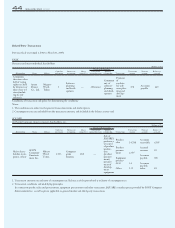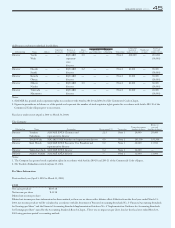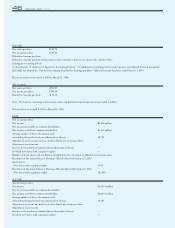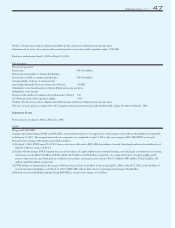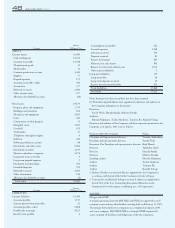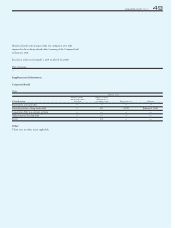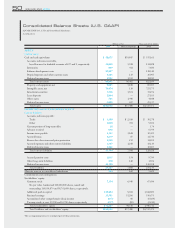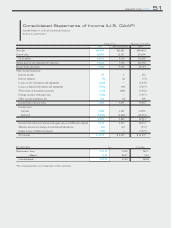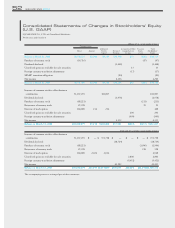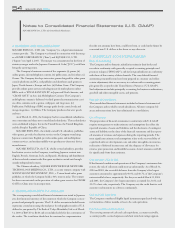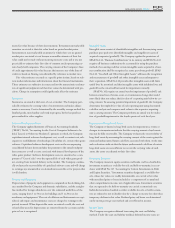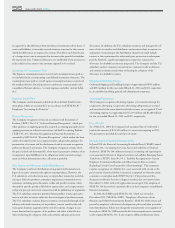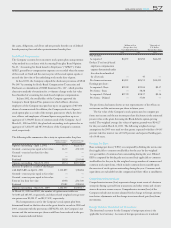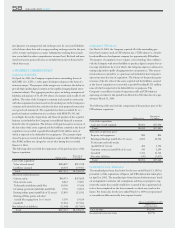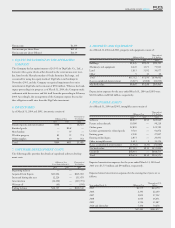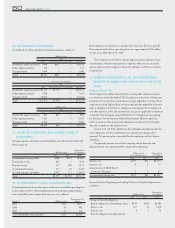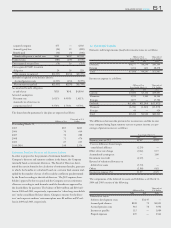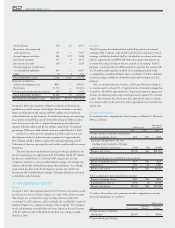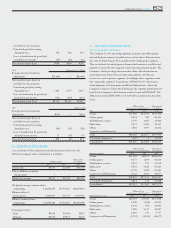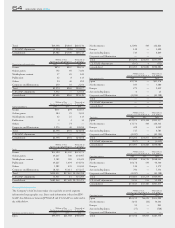Square Enix 2004 Annual Report Download - page 56
Download and view the complete annual report
Please find page 56 of the 2004 Square Enix annual report below. You can navigate through the pages in the report by either clicking on the pages listed below, or by using the keyword search tool below to find specific information within the annual report.
54 SQUARE ENIX 2004
Notes to Consolidated Financial Statements (U.S. GAAP)
SQUARE ENIX CO., LTD. and Consolidated Subsidiaries
1. BUSINESS AND ORGANIZATION
SQUARE ENIX CO., LTD. (the "Company") is a digital entertainment
content provider. The Company was formed in connection with the merg-
er of ENIX CORPORATION ("Enix") and SQUARE CO., LTD.
("Square") on April 1, 2003. The merger was consummated in the form of
statutory merger under the Japanese Commercial Code ("JCC"), with Enix
being the surviving entity.
The Company’s businesses consist of five segments: (i) games, (ii)
online games, (iii) mobilephone content, (iv) publication, and (v) others. (i)
Games: The Company develops interactive games designed for video game
console platforms and PCs, and publishes and distributes such games in
Japan, North America, Europe and Asia. (ii) Online Game: The Company
provides online game services including massively multi-players online
RPGs such as "FINAL FANTASY XI" in Japan and North America, and
"CROSS GATE" in Asia. (iii) Mobilephone Content: The Company’s
mobilephone content is delivered via third party telecommunication carri-
ers offers contents such as games, wallpaper, and ring tones. (iv)
Publication: Publishing of RPG strategy guide books, comic books and
manga magazines. (v) Others: The Company produces character goods
and toys.
As of March 31, 2004, the Company had ten consolidated subsidiaries,
one consortium and three non-consolidated subsidiaries. Three subsidiaries
were established in Japan, five in the United States, the United Kingdom,
and the People’s Republic of China.
SQUARE ENIX, INC., the wholly-owned U.S. subsidiary, publishes
video games, provides localization services to the Company translating
Japanese content into English, provides online game and mobilephone
content services, and markets middle-ware products to electronic device
manufacturers.
SQUARE ENIX LTD., the U.K. wholly-owned subsidiary, provides
localization services to the Company, translating Japanese content into
English, French, Germany, Italy, and Spanish. Marketing and distribution
of the translated content in the European market is carried out through
outside independent licensees.
The Chinese subsidiary, SQUARE ENIX WEBSTAR NETWORK
TECHNOLOGY (BEIJING) CO., LTD., is a joint venture company with
SOFTSTAR ENTERTAINMENT, INC., a Taiwan based video game
publisher, in which the Company holds a 60% interest stake. The venture
has been concentrated on the provision of online game services for CROSS
GATE in China since its incorporation.
2. TRANSLATION INTO U.S. DOLLARS
The accompanying consolidated financial statements are stated in Japanese
yen, the functional currency of the country in which the Company is incor-
porated and principally operates. The U.S. dollar amounts included herein
represents a translation using the mid price for telegraphic transfer of U.S.
dollars for yen quoted by The Bank of Tokyo Mitsubishi, Ltd as of March
31, 2004 of ¥105.69 to $1.00 and are included solely for the convenience of
the reader. The translation should not be construed as a representation
that the yen amounts have been, could have been, or could in the future be
converted into U.S. dollars at the above or any other rate.
3. SIGNIFICANT ACCOUNTING POLICIES
Basis of Accounting
The Company and its domestic subsidiaries maintain their books and
records in conformity with generally accepted accounting principles and
practices in Japan ("JPNGAAP"), and its foreign subsidiaries in conformity
with those of the country of their domicile. The consolidated financial
statements presented herein have been prepared in a manner and reflect
certain adjustments that are necessary to conform with accounting princi-
ples generally accepted in the United States of America ("U.S.GAAP").
Such adjustments include principally accounting for business combinations,
goodwill and other intangible assets, and pensions.
Principles of Consolidation
The consolidated financial statements include the financial statements of
the Company and its wholly owned subsidiaries. All inter-company bal-
ances and transactions have been eliminated in consolidation.
Use of Estimates
The preparation of financial statements in conformity with U.S.GAAP
requires management to make estimates and assumptions that affect the
reported amounts of assets and liabilities and the disclosure of contingent
assets and liabilities at the dates of the financial statements and the report-
ed amounts of revenues and expenses during the reporting periods. The
most significant estimates and assumptions relate to the recoverability of
capitalized software development costs and other intangibles, inventories,
realization of deferred income taxes and the adequacy of allowances for
returns, price protection and doubtful accounts. Actual amounts could dif-
fer significantly from these estimates.
Concentration of Credit Risk
If the financial condition and operations of the Company’s customers dete-
riorate, the risk of collection could increase substantially. As of March 31,
2004 and 2003, the receivable balances from the Company’s five largest
customers amounted to approximately 40.4% and 60.7% of the Company’s
net receivable balance, respectively. For the years ended March 31, 2004
and 2003, the Company’s five largest customers accounted for 21.6% and
30.2% of net sales, respectively. The Company sets the credit limit to each
customer and monitors its solvency continuously.
Cash and Cash Equivalents
The Company considers all highly liquid instruments purchased with origi-
nal maturities of three months or less to be cash equivalents.
Fair Value of Financial Instruments
The carrying amount of cash and cash equivalents, accounts receivable,
accounts payable, accrued expenses and short term borrowings approxi-


